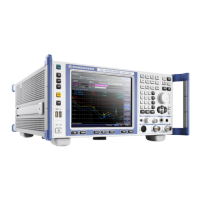Receiver Mode
R&S
®
ESR
168User Manual 1175.7068.02 ─ 12
Average detector
The average detector yields the average level of the samples of the samples measured
during the set measurement time.
With average detection selected, the video voltage (envelope of IF signal) is averaged
during the measurement time. Averaging is digital, i.e. the digitized values of the video
voltage are summed up and divided by the number of samples at the end of the mea-
surement time. This corresponds to a filtering with a rectangular window in the time
domain and a filtering with sin x/x characteristic in the frequency domain.
With modulated signals the measurement time is determined by the lowest modulation
frequency to be averaged. With pulse signals, the selected measurement time should
be long enough for sufficient number of pulses (>10) to occur in the measurement win-
dow for averaging.
Regarding measurement time,
●
with unmodulated signals the shortest possible measurement time can be selected.
●
with modulated signals the measurement time is determined by the lowest modula-
tion frequency to be averaged.
●
with pulse signals, the selected measurement time should be long enough for suffi-
cient number of pulses (>10) to occur in the measurement window for averaging.
Average and RMS detector in Time Domain Scan
Note that it is not possible to use the Average detector and the RMS detector at the
same time when performing a Time Domain Scan.
RMS detector
The RMS detector evaluates the root mean square (RMS) value over the specified
measurement time and displays the resulting value. The integration time is the speci-
fied measurement time.
Regarding measurement time,
●
with unmodulated signals the shortest possible measurement time can be selected.
●
with modulated signals the measurement time is determined by the lowest modula-
tion frequency to be averaged.
●
with pulse signals, the selected measurement time should be long enough for suffi-
cient number of pulses (>10) to occur in the measurement window for averaging.
RMS detector and VBW
If the RMS detector is selected, the video bandwidth in the hardware is bypassed.
Thus, duplicate trace averaging with small VBWs and RMS detector no longer occurs.
However, the VBW is still considered when calculating the measurement time. This
leads to a longer sweep time for small VBW values. Thus, you can reduce the VBW
value to achieve more stable trace curves even when using an RMS detector. Nor-
mally, if the RMS detector is used the measurement time should be increased to get
more stable traces.
Measurement Basics

